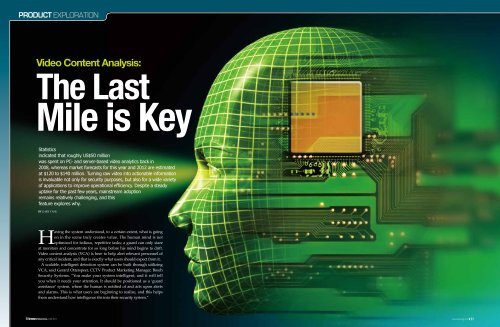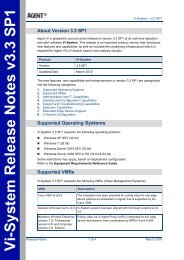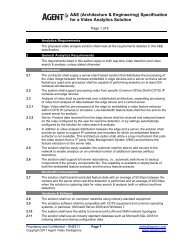Video Content Analysis: - Agent Vi
Video Content Analysis: - Agent Vi
Video Content Analysis: - Agent Vi
Create successful ePaper yourself
Turn your PDF publications into a flip-book with our unique Google optimized e-Paper software.
Product Exploration<strong><strong>Vi</strong>deo</strong> <strong>Content</strong> <strong>Analysis</strong>:The LastMile is KeyStatisticsindicated that roughly US$50 millionwas spent on PC- and server-based video analytics back in2008, whereas market forecasts for this year and 2012 are estimatedat $120 to $140 million. Turning raw video into actionable informationis invaluable not only for security purposes, but also for a wide varietyof applications to improve operational efficiency. Despite a steadyuptake for the past few years, mainstream adoptionremains relatively challenging, and thisfeature explores why.By Gary TangHaving the system understand, to a certain extent, what is goingon in the scene truly creates value. The human mind is notoptimized for tedious, repetitive tasks; a guard can only stareat monitors and concentrate for so long before his mind begins to drift.<strong><strong>Vi</strong>deo</strong> content analysis (VCA) is here to help alert relevant personnel ofany critical incident, and that is exactly what users should expect from it.A scalable, intelligent detection system can be built through utilizingVCA, said Gerard Otterspeer, CCTV Product Marketing Manager, BoschSecurity Systems. “You make your system intelligent, and it will tellyou when it needs your attention. It should be positioned as a ‘guardassistance’ system, where the human is notified of and acts upon alertsand alarms. This is what users are beginning to realize, and this helpsthem understand how intelligence fits into their security system.”50 22 JUN 2011www.asmag.com 2222 JUN 2011www.asmag.com 22 51
Product ExplorationThe key word was assistance, notreplacement, as VCA can do manythings, but it is not as magical assome make it sound. <strong><strong>Vi</strong>deo</strong> analyticsis a science — one with clearlydefined rules that must be followedfor optimal results, Otterspeer said.“VCA provides additional benefitsin modern surveillance systems andits overall value further justifies theinvestment in an advanced surveillancesystem.”“ A s u r v e y w e d i d o f 1 , 2 0 0customers this year has shownthat good video analytics was themost important component oftheir security system,” said Ivy Li,cofounder and MD of iOmniscient.“For more sophisticated users, thevalue of having a camera diminisheswhen it does not have videoanalytics, and they question whythey need the camera at all.”Smoke and Mirrors<strong><strong>Vi</strong>deo</strong> analytics has been around forquite a while, but has not seen wideradoption over the years. One reasonmay be unrealistic expectations fromend users. These expectations werebuilt up in the early days by overaggressivemarketing, and later fueledthrough movies and TV shows, onlyto have end users disappointed inwhat could actually be delivered.O v e r s e l l i n g f e a t u r e s t h a tclearly need more R&D beforereaching commercial viabilitycan be problematic, said ThejaswiBharadwaj, Head of CivilianTechnologies at Delopt. “Theoverselling of premature algorithmsover several years has unfortunatelyworked, and customers expecthuman-level accuracies. Efforts fromVCA solution providers are requiredto communicate with consultantswho draw up project specifications.”Educating the market is, thus,critical for VCA to be successful,Otterspeer echoed. “Hollywoodproductions generate a ‘CSI effect’that sticks in people’s minds. Theyhave amazing special effects forintelligent video to ‘wow’ people, butreality is a bit different.”When users’ high hopes werebeaten down by a myriad of falsealarms, some customers actuallyturned off analytic capabilities, saidSteve Gorski, GM for the Americas,Mobotix. “The industry has learnedmuch more about market needs andthe technology to offer fully robustsolutions that provide significantvalue to the endc u s t o m e rt o d a y. ”▲ Many providers are not upfront about the limitations of VCA; userswith unrealistic expectations ultimately dismiss VCA as hype.The focus is now on the analytics thatprovide the most operational value,such as people counting, loiteringand directional detection.“Many users have had very poorexperiences with poor-qualityproducts and are hesitant to spendmoney again. I believe this hasaffected overall growth in themarket,” Li said. “But note thatthe market still exists. Most ofour projects involve thousands ofcameras. The largest one that weare working on now has well over100,000 cameras.”Another reason for someVCA companies todayinvolve commitmentissues, Li continued.Many vendors havesignificant venturec a p i t a l ( V C ) b a c k i n g . “ V C susually have an expectation of anexit strategy within two to threeyears. Their focus is on having theminimum acceptable technology, andthey then attempt to get a few salesso that they can position themselvesfor an exit. In virtually all thesecompanies, there is very little focuson improving their technology. Withpoor technology generating lotsof false alarms, it is very difficultfor such companies to grow sales.When the VCs grow impatient, thesecompanies shut down and leave abad name for VCA. Users have beenscarred and become wary of similartechnology,” Li said.Empty PocketsAnother factor is cost. "Therehave been cost barriers to analyticsbeing installed more widely —not just the cost of purchasingbut also time required from staffto install, fine-tune, manage andmaintain systems with analytics,"said Christian Bohn, VP of ProductManagement and Marketing atMilestone Systems. “Furthermore,they are processing-heavy on thesystem and require more power inthe hardware, so the investmentis not just in buying the software.Typically, after installing analytics,fewer cameras can be operated perGerard Otterspeer, CCTV ProductMarketing Manager, Bosch Security SystemsIvy Li, Cofounder and MD ofiOmniscient▲ Sophisticated VCA implementations come with a hefty price, and the financial crisis further hindered wide adoption.server. This adds to the overall costand complexity of an installation.”Intelligence on EdgeTherefore, many solution providersare moving the processing elsewhereand are looking to embed intelligencein their cameras, Gorskisaid. “There are many benefits inincorporating analytics onto theedge. This approach dramaticallyreduces bandwidth and storagerequirements by eliminating theneed to send irrelevant video dataacross the network to a centralizedserver. Decentralization enhancesefficiency.”For some applications, intelligenceon the edge is a must, OtterspeerThejaswi Bharadwaj, Head ofCivilian Technologies, Deloptadded. “Raw data is processed tomake sure everything is analyzed.It is also much more scalable. Whenyou add a camera, you are alsoadding processing horsepower, asopposed to constant upgrades in acentralized environment.” Powerusage of a smart network camera isalso significantly less than that of acentralized server.When there is no need for acentralized server, licensing expensesin the server’s operating system canbe saved, Otterspeer said. “In thelong run, this reduces the TCO forthe end user.”Processing No Longer ABottleneckLooking beyond surveillance,c e l l u l a r a n d m o b i l e d e v i c e sare increasingly powerful andaffordable. “Consumers today arebuying millions and millions ofmobile devices; as a result, chip costsare coming down, creating a greatopportunity for VCA,” Otterspeersaid. “Having a dedicated chipfor VCA allows the camera to becapable of ensuring optimal imagequality, while delivering the full52 JUN 201122 www.asmag.com 22 22 JUN 2011www.asmag.com 22 53
Product Exploration▲ What users need to understand is that VCA does provide additional value to the surveillance system when implemented correctly.potential of VCA. There need not bea compromise.”More powerful and affordableprocessors, in turn, drive morecomplex VCA features into cameras,said Patrick Lim, Director of Salesand Marketing for Ademco Far East.“Hopefully, cameras will becomeincreasingly smarter. They couldadjust intelligently for diverselighting and weather conditions aswell as nonenvironmental patterns,such as a diverse range of humanactivities, to assist in preemptiveintelligence.”“ Ty p i c a l l y, ' l i g h t e r ' V C Aimplementations are seen onthe edge to provide more basicfunctions, whereas more processingdemandingalgorithms and applicationsstill get deployed centrally,”Bohn added.If the software is optimized, theVCA features should have very littleeffect on the performance of theprocessor, added Ed Troha, MD ofGlobal Marketing at Object<strong><strong>Vi</strong>deo</strong>.“If the software is inefficient, it willtake up excessive resources no matterhow powerful the processor is.”Despite all the processor developments,a main challenge for VCAremains, and that is the lack of acommon processing platform acrossmanufacturers, Bharadwaj said.“For example, each camera vendorhas a different processor type. Thisrequires VCA companies to invest ahuge amount of R&D in supportingeach manufacturer.”Servers Making a ComebackVCA on edge devices is growingin terms of market size, but sois server-based intelligence, saidZvika Ashani, CTO of <strong>Agent</strong> <strong><strong>Vi</strong>deo</strong>Intelligence. “Due to processingpowerlimitations, VCA whichresides completely inside theChristian Bohn, VP of ProductManagement and Marketing, MilestoneSystemsPatrick Lim, Director of Sales andMarketing, Ademco Far Eastedge device is mostly limited torelatively simple applications, suchas tampering detection, peoplecounting and directional movementdetection.”“When you need to performanalytics or correlate metadata onlive or stored video from hundredsof cameras, you need the greaterprocessing power and centralmanagement capabilities of a serverbasedsolution,” Bohn said. “Serverbasedanalytics enable more complexanalytics and fast searches througharchived video. Server solutions arealso critical for making a variety ofvideo analytics tools available tovarious departments, from securityto operations and marketing, andallowing for searches of after-the-factanalyses, such as facial recognition,that are beyond the capabilities ofon-camera solutions.”A future-proof solution is to enablevideo analytics at both ends — serverand edge, Bohn continued. “Theneed for a strong video managementsystem with a unified yet flexibleintegration framework will alsobecome more evident, as the valueof querying across metadata fromdifferent edge devices from multiplevendors will be very high.”A s u r v e i l l a n c e s y s t e m t h a ti n t e g r a t e s i n f o r m a t i o n f ro mEd Troha, MD of Global Marketing,Object<strong><strong>Vi</strong>deo</strong>multiple VCA-enabled cameras toa central server does offer a betterpicture of the entire monitoredarea, Lim agreed. “The system cantake preemptive actions, such astriggering brighter lights where theintruder is detected or notify securityto intercept the escape.”There should be no debate of whereVCA should reside, Troha added.“It all depends on how value canbe delivered to the end user. VCAis only an ingredient in the videosystem and its purpose is to help theend user extract the most value fromtheir investment in advanced surveillance.”The end goal is to employ technologiesthat give the customer anoptimal solution, Bharadwaj said.“VCA in itself is not a ‘be all, end all’solution; to maximize overall systemreliability, even analytics solutionsthat are not video-based need to beintegrated.”Hands TiedMore affordable central processingalso means that more channels can besupported, Bharadwaj said. “Ideally,all analytics need to reside insidethe camera. Analytics that need‘inter-camera’ collaboration need tobe handled smartly. However, thereare two practical challenges at thepresent time.”One is the absence of a commonVCA interface across cameram a n u f a c t u r e r s , B h a r a d w a jcontinued. “Ideally, applicationdevelopers would want to code/test once and incorporate this intodifferent cameras from multiplevendors. This will provide flexibilityto the end customer in choosing anycamera vendor for different stages ofimplementation. At the present time,if the customer chooses an on-cameraVCA solution, they are constrainedto using cameras from vendors thatare supported by the on-camera VCAcompany for further expansions.VCA companies that provide serverbasedimplementations are morecamera-agnostic and future-proof.”The other is a current lack of collaborationbetween VCA developersand camera manufacturers. “Ideally,the camera vendor would providehardware and basic software onlyand leave all other features andcamera resources to be used by theVCA or other application vendor.54 JUN 201122 www.asmag.com 22 22 JUN 2011www.asmag.com 22 55
Product ExplorationTo use a PC analogy, Dell makes thehardware, and Microsoft or Linuxprovides the operating system; it isentirely up to developers to createany application that they want,”Bharadwaj said.Driving Further GrowthAll technologies have limitations.Having an educated andknowledgeable customer ensuresthat the system will be successful,Li said. “There have been manyinstances where we have walkedaway from projects, as we did withthe Commonwealth Games inDelhi, even though we had beeninvolved with the previous Gamesin Melbourne. Sometimes, endusers have no understanding of thetechnology that they are asking for,and would not be able to deploy iteffectively. In situations like that, it isbetter to walk away from the projectrather than let it affect reputation.”Some say organizations avoid VCAbecause of their resistance to change.However, Otterspeer feels that it ismore about caution of risk ratherthan resistance to change that ispreventing VCA from gaining better▲ Providers should communicate clearly to end users what VCA can and cannot do.traction. “In security,customers are verycareful with chances.They want solutionsthey can trust. We needto earn that trust to beable to sell our products,and that is why we needto educate the market.”Most installers knowwhat they are doing.They are trained andZvika Ashani, CTO of <strong>Agent</strong> <strong><strong>Vi</strong>deo</strong>Intelligencehave been using the same systemon a daily basis, but they need toexplain to the end user the differencebetween CSI and reality, Otterspeercontinued. “Demo software providesthe opportunity for the customerto try all the different elements inreal-life situations and see if it worksin their security environment. Theycan play, for instance, with colordetection on finding guys in redshirts. This allows users to makeeducated purchases and maintainrealistic expectations.”Sometimes, it is the terms usedwhen speaking to customers thatgive the wrong impression of whatVCA can really provide, said TimChandler, President of CoastalCOMSTim Chandler, President ofCoastalCOMS Division, CoastalwatchDivision, Coastalwatch. “Forinstance, the term ‘people counting’often is understood as ‘an exactcount of people’ and nothing else.However, we often find that’s notwhat customers really need toanswer their business or workflowquestion. VCA in our world isa tool for a decision supportmanager.” Ultimately, the technology’scapability alone is not whatone should focus on, but rather thecombined relevance of VCA outputto a specific business question.“We had once been asked to counton a beach that easily had 10,000people on it constantly coming andgoing, and ultimately had to askthe customer what decision treethey were really trying to support,”Chandler said. “Did they want toknow how many people were onthe beach each exact second? Didit matter if the beach suddenlylost or gained 150 people over thenext minute? In the end, a rangeapplied to a timeline was more theoutput they were looking for, whichis serviceable with a reasonableconfidence level versus trying to getan exact count in real time.”Part 2 of this feature will look athow VCA is deployed in real lifeand key factors to consider whenevaluating a solution.56 JUN 201122 www.asmag.com 22 22 JUN 2011www.asmag.com 22 57











